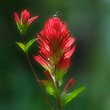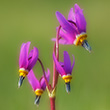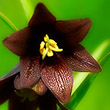
In the Field
Emergent Prickly Rose. Findlay Creek, BC, Canada. June 4, 2005.
This wild rose was just about to open when I captured this image. I wanted to limit the zone of sharp focus to the edges of the curled petals, so I chose my longest macro lens and positioned the lens very close to the flower (near the close-focus limit of the lens). With the subject this close I knew I could stop down the aperture a little (to maximize the sharpness of the petal edges) and still throw the bulk of the image out of focus.
I also wanted to retain a little of the pink colour inside the flower, so I used a ring-flash to add just enough light to lighten the hard shadows.
Behind the Camera
Emergent Prickly Rose. Findlay Creek, BC, Canada. June 4, 2005.
Digital Capture; Compressed RAW (NEF) format; ISO 100.
Nikon D2X with Nikon AF Micro 200 mm f/4 ED lens (300 mm equivalent with digital conversion factor) supported on Gitzo G2220 Explorer tripod with Really Right Stuff BH-55 ballhead. Sigma EM-140DG Macro flash. Nikon MC-20 cable release.
1/50s @ f6.3; no compensation from matrix-metered exposure setting; balanced TTL flash exposure with -0.67 stop compensation on EM-140DG. Shutter triggered with mirror-up.
At the Computer
Emergent Prickly Rose. Findlay Creek, BC, Canada. June 4, 2005.
RAW Conversion to 16-bit TIFF, including first-pass sharpening, exposure compensation, and tone curve adjustment, using Phase One's C1 Pro.
All further digital correction on 16-bit TIFF file using Adobe's Photoshop CS2, including selective saturation enhancement, and selective sharpening for web output.
Conservation
Emergent Prickly Rose. Findlay Creek, BC, Canada. June 4, 2005.
Ten percent of the revenue generated by this image will be donated to Wildsight.
Species Status in Canada*: This species is not designated as at risk.
Prickly Rose (Rosa acicularis) is a deciduous shrub that bears multiple pink, buttercup-like flowers each of which bears 5 broad single petals. They can be found in a wide variety of habitats from northern Canada south to New Mexico. Following blooming, the flower transforms itself into the scarlet pear-shaped fruits known as rose hips. The rose hips themselves are used as food by birds and mammals and are unusually high in vitamins A and C. Some advanced primates (i.e., people) use rose hips to make jams, jellies, syrups, marmelades and juice.
This Prickly Rose was photographed in the Columbia Valley of the East Kootenays. While this species is not currently not considered at risk, like many other species local populations are very vulnerable to habitat loss. Many ecosystems within the Columbia Valley face development pressure, including pressure from logging operations. Wildsight is an effective conservation organization that protects biodiversity and promotes sustainable communities in Canada's Columbia and Rocky Mountains. Support for Wildsight, through donation or becoming a member, will help ensure that they remain effective in their efforts to conserve threatened or endangered species and ecosystems.
*as determined by COSEWIC: The Committee on the Status of Endangered Wildlife in Canada
























